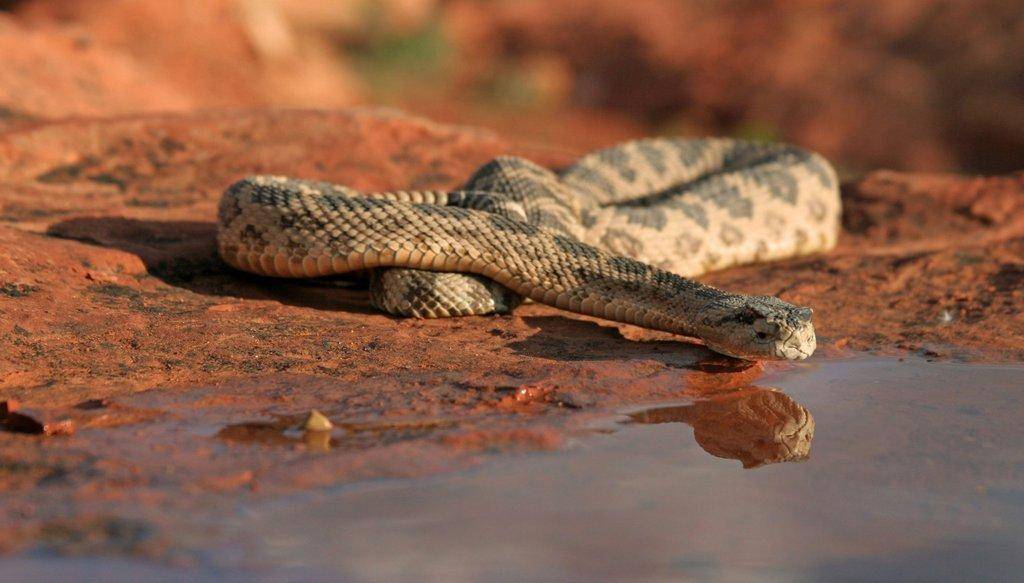DWR News Release
Rattlesnakes strike fear in the hearts of some people, but they shouldn’t. Knowing a little about how these reptiles behave and doing a few simple things can go a long way in keeping you and the snakes safe.
Five rattlesnake species live in Utah, the most common of which is the Great Basin rattlesnake. This is the time of year when Utah rattlesnakes are on the move, looking for water and rodents after emerging from their winter dens. Due to the drought conditions this year, Utahns may see more snakes in their yards or irrigated fields, searching for water. Snakes need water, but they don’t need as much water as most mammals and birds.
Rattlesnakes are most active during the summer at dawn and dusk. Snakes mainly eat rodents, birds and other reptiles. Rocky, high-elevation slopes are the places in Utah where you are most likely to encounter rattlesnakes; however, a rattlesnake’s camouflage helps it to blend into its surroundings, so you may pass by a rattlesnake and never know it.
Rattlesnakes are protected under Utah law, making it illegal to harass or kill one. The only exception to this is if you are threatened and defending yourself; otherwise, it is a class B misdemeanor to kill a rattlesnake. They are an important part of Utah’s ecosystem and help keep the rodent population in check.
You may see a rattlesnake while out camping or hiking this summer. However, snake bites are quite rare, and most people who are bitten by rattlesnakes are harassing or trying to illegally kill the snake. Like most animals, rattlesnakes fear humans and will do anything they can to avoid us.
“However, that changes if a snake thinks it’s threatened and there’s no way to escape,” DWR Native Species Coordinator Drew Dittmer said. “In that case, the snake will often strike to protect itself. Just don’t approach it. Give it plenty of space, and leave it alone. Respect the snake, and you will be safe. If you are bitten by a rattlesnake, seek immediate medical attention.”
When you are out hiking, make sure to always watch the trail ahead of you, and to check carefully before stepping over rocks, reaching onto ledges or sitting down on a rock or log.
What to do if you encounter a rattlesnake
-
Remain calm and do not panic. Stay at least five feet from the snake. Make sure to give it plenty of space.
-
Do not try to kill the snake. Doing so is illegal and greatly increases the chance the snake will bite you.
-
Do not throw anything at the snake, like rocks or sticks. Rattlesnakes may respond to this by moving toward the person doing the throwing, rather than away from them.
-
Alert other people to the snake’s location. Advise them to use caution and to respect the snake. Keep children and pets away from the area.
-
Keep your dog on a leash when hiking or camping. Allowing your dog to roam around increases the chance the dog will find a snake and get bitten.
-
If you hear a rattle, don’t jump or panic. Try to locate where the sound is coming from before you react so you don’t step closer to the snake or on top of it.
Keeping rattlesnakes out of your yard
Depending on where you live, you could find a snake in your yard. Aside from building a fence that rattlesnakes can’t penetrate, here are some other useful tips to help keep rattlesnakes out of your yard:
-
Reduce the number of places that provide snakes with shelter. Brush, wood, rock and junk piles are all things you should eliminate from your yard.
-
Control rodent populations. Bird feeders and water are two of the main items that draw rodents to yards, which in turn can attract snakes.
-
Avoid scaring away harmless snake species, such as gophersnakes. Having other snake species on or near your yard may deter rattlesnakes.
Identifying a rattlesnake
Gophersnakes (the most widespread and abundant snake species in Utah) are often mistaken for rattlesnakes because when alarmed, gophersnakes hiss and vibrate their tails. A rattlesnake’s tail is wide and blunt — and tipped with a rattle, of course — while a gophersnake’s tail is slender, pointed and lacks a rattle. Rattlesnakes also have broad, triangular-shaped heads and vertical eye pupils, while non-venomous snakes in Utah have longer snouts and round pupils.
If you can’t identify the snake from a distance, leave it alone and treat it as if it were venomous.
You can get additional rattlesnake safety tips on the Wild Aware Utah website.

